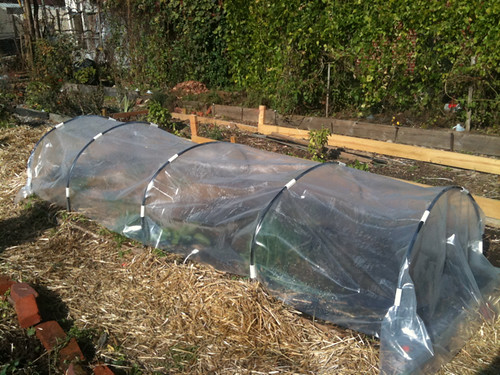 Chinese cabbage and daikon from last year's garden
Chinese cabbage and daikon from last year's garden
In our garden this time of year, I grow a lot of Asian greens for a couple of reasons: first, they germinate and grow extremely fast and secondly, supermarkets and even farmers markets tend to have just a sampling. Asian markets in the suburbs have more choice, but the quality can be iffy and the veggies aren't organic.
So as the summer heat finally died down, I sowed mizuna, mibuna, Chinese broccoli, daikon, bok choi, tat soi, two varieties of Chinese cabbage, mustard, turnips, red carrots, as well as a couple of varieties of lettuce that I don't often find, like red iceberg, a heirloom. I'll be drowning in Asian greens and lettuce in about 6-10 weeks and making my own kimchi.
I thought about this approach - grow what you can't buy - when I read this interesting piece about a gardener in England, Mark Diacono, who has a new book, Taste of the Unexpected. He talks about how he decided what to grow:
I did a little research, whittling out the truly impossible as well as anything cheap and widely available. What was left formed my first wishlist: mulberries, apricots, medlars, persimmons, quinces, pecans, olives, peaches, walnuts, mizuna, Szechuan pepper, kai lan and almonds. What a menu. Otter Farm was on its way.
On top of that, he bet climate change would make it possible to grow plants more common to the Mediterranean than the UK.
Apricots, peaches and nectarines, among others, will get plenty enough sun in England to ripen happily, but the frosts can nip the blossom and kill off any chance of fruit. I was convinced that climate change would make those late frosts fewer and farther between, so I planted.
What I liked most was this list of how to think about what to plant. So here's Diacono's 13 steps (edited a bit from the full list at the Guardian link above):
1. Drawing up your wishlist is the key step ... forget about any limitations your garden may have and think imaginatively. Let flavour be your guide.
2. Grow what you most like to eat. Make a list of all the food you love. Add to it anything you love the sound of.
3. Grow what you can't buy. Some homegrown foods bear little resemblance to those in the shops. Grow them for yourself and get them to the kitchen within minutes and they will taste luxurious.
4. Grow something unexpected. Quinces, mulberries and salsify are three of the many that don't suit the supermarket system, and all are among the very finest food you can eat.
5. Challenge your tastebuds. If you hate it, grow it, at least once. Chances are it'll be so far removed from what you buy in the shops, or be so fine in combination with something else you grow that you'll be converted.
6. Grow food that's expensive to buy. It makes little sense to grow the cheap stuff and keep forking out for the pricier food, but that's exactly what most people do. Grow something delicious and expensive instead.
7. Transformers. The transformers are those harvests that ensure your main crops have any number of costumes to dress up in. They are typically long on flavour and short on volume – herbs, Szechuan pepper, Egyptian walking onions, etc.
8. Think seasonally. It can be tempting to concentrate on the height-of-summer loveliness, ignoring the fruit, greens, buried treasure, salads and nuts from the other parts of the year.
9. Quick return. Like most things, growing is about confidence and momentum, so enjoy the taste of success early. Include some cut-and-come-again salad leaves, intense microleaves and pinch off day-lily flowers within a few weeks or even days of them starting to grow and you'll taste the difference.
10. Go for diversity. Generally speaking, a little of lots rather than lots of a little is what you're after. Go for a broad range of foods as well as a number of varieties of each.
11. Aesthetics. A beautiful plot is undeniably more compelling to be in. Foster your own sense of the beautiful, afford it importance and you'll find your patch the place you most want to be for your morning coffee.
12. Get catalogues. When picking plants go to someone who does it for a living: they know what they're doing and they have an interest in you coming back.
13. Be realistic about your time. In the first year, bite off less than you can chew. If I gave you a tomato plant to look after you'd probably find the time; if I gave you a two-acre field you might find other commitments get the better of you.
HT to my friend the writer Roger Atwood who alerted me.
- Samuel Fromartz
For the past three years, I've tried to grow cantaloupe in my community garden plot in Washington, DC.




 , which is $21 and change over at Amazon, for the bargain basement price of $1.99 in an iPhone app -- that is, if you've already spent hundreds on the iPhone itself.
, which is $21 and change over at Amazon, for the bargain basement price of $1.99 in an iPhone app -- that is, if you've already spent hundreds on the iPhone itself.